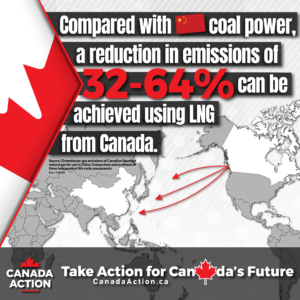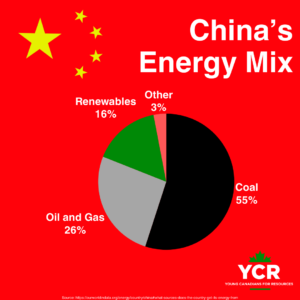Aiden Gonsalves – January 17, 2023
China’s Energy Mix: Paradox and Opportunity
China is home to more than 1.4 billion people – approximately 35 times the population of Canada. That’s 1.4 billion people who need electricity, heat, and fuel to live and work. Plus, with the second largest economy in the world, China needs an astounding amount of energy to keep economic development flowing in its rural agricultural regions, vast industrial complexes, and densely populated urban centers.
How does China provide energy to so many people and such a large economy? Where does all this energy come from?
Below, I examine what China’s energy mix looks like and explain why Chinese energy policy is being called a paradox. I then identify 3 key opportunities for Canada to get more involved in China’s renewable energy future.
China’s Energy Mix
A paradox is a statement or concept that is seemingly contradictory or opposed to common sense and yet is perhaps true. This is how many economists, scholars, and journalists describe China’s relationship with energy. Let’s look at the statistics to understand why.
China leads the world in completion of renewable energy projects and dominates global supply chains for clean energy materials (like solar panels and EV batteries). A recent Goldman Sachs report found, for example, that China controls 90% of the global market for upstream solar products.
In addition to being a leading producer of renewable energy products, China is also vastly increasing its consumption of renewable energy itself. China has doubled its consumption of renewable energy as a percentage of total energy consumed since 2010 – it’s estimated that approximated 16% of China’s energy consumption today is from renewable sources like hydroelectricity, wind, and solar.
While already being home to almost half of the world’s wind and solar generating capacity, China is on track to double that capacity in the next few years. In fact, construction of renewable projects in China has been so aggressive that the country will likely meet its targets for renewable energy capacity 5 years ahead of schedule.
Without a doubt, China is a global leader in renewable energy development.
But where does the “paradox” idea come in? Well, China’s progress with renewables is only half the story. To get the full picture, we need to look at what else China is up to. I mentioned that around 16% of China’s energy comes from renewable sources. What about the other 84%?
Coal makes up more than 55% of China’s energy mix. A further 26% comes from oil and natural gas. Fossil fuels vastly overshadow renewable energy in the country’s energy mix. Despite leading the world in renewables development, fossil fuel usage is over 5 times renewable energy usage in China.
China burns more coal every year than the rest of the world combined.
In 2022, China’s coal consumption was 88.41 exajoules. I don’t know what an exajoule is (and I’m sure you don’t, either), but China’s consumption outsized the next largest consumer – India – by nearly 5 times. Considering that India has a slightly larger population than China, that really puts China’s coal usage into perspective.
In addition to being the world’s largest coal consumer, China is also the world’s largest coal producer. Home to the fourth largest coal reserves worldwide, China domestically mines most of the coal it burns – as much as 90% of it.
It doesn’t seem like coal production and usage are trending downwards, either. Last July, it was estimated that mainland China is home to 1,140 coal power plants – with more being built each month. A 2023 report found that the Chinese government is approving the equivalent of two new coal power plants every week.
China’s energy mix is truly a paradox. While being a global leader in renewable development, China is also the world’s foremost producer and consumer of coal – an extremely harmful energy source.
The Chinese government commits to becoming carbon neutral by 2060. In the same vein, it approves dozens of new coal plants per year across the country’s 22 provinces.
It’s important to note that a major reason for this energy paradox is energy security concerns on the part of the Chinese government. Experts say that China’s reliance on coal stems in large part from the country’s abundant coal reserves, cheap production costs, and the ability to be self-sufficient if geopolitical relationships break down. Self-sufficiency has been a large component of China’s energy policy for many decades – the mindset first developed when Mao Zedong and the Chinese Communist Party came to power in 1949.
Rationale aside, what does China’s energy paradox mean for the rest of the world? What opportunities does it present for Canada?
Opportunities for Canada
Shanghai – China’s largest city – is more than 9,000 km away from British Columbia’s rugged coastline. Though seemingly distant, the effects of China’s energy transition most definitely affect Canada’s economy and energy future, as well.
Here are 3 concrete opportunities for Canada to contribute to China’s energy transition:
1. Copper
Copper is one of the most important metals in a decarbonizing world – it’s essential to the renewable energy transition. Copper is a highly efficient conduit – meaning it’s a good conductor of electricity – and is used in renewable technology across the board, from solar panels to wind turbines to EVs.
As we know, China is leading the global push in terms of renewable energy. To continue building and operating these renewables projects, China needs a massive amount of copper (not to mention the copper the rest of China’s giant economy requires). In 2022, China imported $75.5 billion worth of copper, making it the world’s largest copper importer by a country mile.
Though China’s domestic copper mining sector is starting to grow to meet its demand, China will still need to import a growing amount of copper (specifically copper ore) as renewable energy sources continue to grow within the country’s energy mix.
This is where Canada comes in.
Canada holds 1% of the world’s copper reserves (meaning copper that’s in the ground) – this is very little compared to Chile at 23% and Australia at 11%, for example. However, even with only 1% of the global pie, Canada managed to export $4.2 billion worth of copper in 2021. That’s nothing to sneeze at.
Where does Canada export this copper? Well, it’s exactly where you might think. China and Japan are the two largest importers of Canadian copper. In fact, a lot of the Canadian copper China imports comes from mines in BC.
There’s a growing concern that Canada shouldn’t be exporting it to China for various geopolitical and macroeconomic reasons.
However, Canada’s domestic capacity for refining copper ore into products it can use is severely lacking. Until Canada decides to build copper refineries at home, selling raw copper to countries that need it (like China) is necessary.
While the $4.2 billion it exports in copper is a good start, Canada must increase sustainable and ethical copper mining if it wants to play a meaningful role in the renewable energy transition at home, in China, and around the world. Copper mines in BC, Manitoba, Ontario, and Quebec can be crucial suppliers of materials for renewable technologies going forward.
2. Liquified Natural Gas (LNG)
The negative climate impacts of coal usage cannot be overstated. Numerous other YCR articles have discussed this, so I won’t get into the details and statistics here. Needless to say, China’s aforementioned coal consumption is a major reason why it’s the world’s top carbon emitter.
Though China’s rapid approval of coal power plants signals a steady increase in carbon emissions (despite the government committing to reduce those emissions at the same time), it doesn’t have to be this way.
Enter LNG.
LNG is natural gas that has been cooled to around -160 degrees Celsius (a process called liquefaction). In its chilly, liquid state, the natural gas can be easily transported, heated back up, and burned to fuel whatever needs fueling. As we know, LNG is much better for the environment (meaning significantly less CO2 emissions) than coal.
As it is, China is looking to increase its LNG usage as a proportion of total energy consumption. Though domestic production can meet some of the demand, numerous recent international LNG deals signal that China will increasingly require imported LNG going forward.
Canada has an opportunity to sell some of the world’s cleanest and most ethically produced LNG to China. From Canada’s west coast – at ports in Vancouver, Kitimat, and Prince George, for example – Canada can easily export LNG across the Pacific Ocean to the Asian market. That would translate to tons of coal replacing LNG for China, Japan, and other Asian countries.
So, what’s the hold-up? Though projects like LNG Canada and, recently, Ksi Lisims LNG, lead the charge and give hope to the Canadian energy sector that the regulatory challenges may soon be letting up, construction of many other proposed LNG projects – including processing, storage, and export facilities – has been slowed due to various obstacles. A major obstacle is the regulatory burden vis-à-vis permitting, but I won’t tackle that topic here.
What’s important is that Canada has a golden opportunity to sell LNG to China and other Asian countries. Doing so will help to significantly reduce carbon emissions as these countries move from coal to LNG –getting Canadian LNG to Asia could achieve massive emissions reductions.
3. Lead by Example
In addition to beefing up copper and LNG exports to China, Canada also has an opportunity to further cement itself as a leader in the global energy transition. In doing so, it can play a role in helping China evolve its energy policy going forward.
According to the International Energy Agency, “we need greater policy efforts and investments – backed by stronger international cooperation – to drive a massive surge in clean energy and energy efficiency to reduce coal demand” in China and other energy-hungry Asian markets.
As mentioned above, China’s energy policy is deeply interconnected with its energy security and geopolitical concerns. But, as part of the broader international effort, Canada can play a meaningful role in reducing China’s carbon emissions and coal reliance.
As part of the G7 and its “Clean Energy Economy Action Plan”, for example, Canada can play a role in influencing other countries to meet climate targets by striving to meet its targets. Under this G7 plan, Canada has, among other things, committed to investing in “the industries of the future” to achieve lower emissions and lower the costs of the energy transition globally.
Further, Canada’s commitments under the Paris Agreement – and how the country goes about achieving those commitments – can set an example for major emitters like China.
China’s own Paris Agreement commitments include peaking CO2 emissions by 2030 and increasing the share of non-fossil fuel energy consumption to 20%. Though it would be naïve to assume that Canada’s climate action alone could influence China, Canada must play its role in reducing its own emissions if global emissions reduction is the goal.
Be the change you want to see in the world, right?
What Young Canadians Can Do
No one person can single-handedly reduce China’s carbon emissions or reduce its reliance on coal. Nor will these changes happen overnight. China’s energy transition will span over multiple decades and will require global cooperation from governments and industry.
That said, if this article interests you and you’d like to learn more or get involved, here are some actionable steps you can take:
- Read about the Paris Agreement and keep track of how China (and Canada) are progressing
- Learn about the benefits of switching from coal to LNG (and share what you learn with others)
- Reduce your own carbon footprint
- Get involved with YCR

